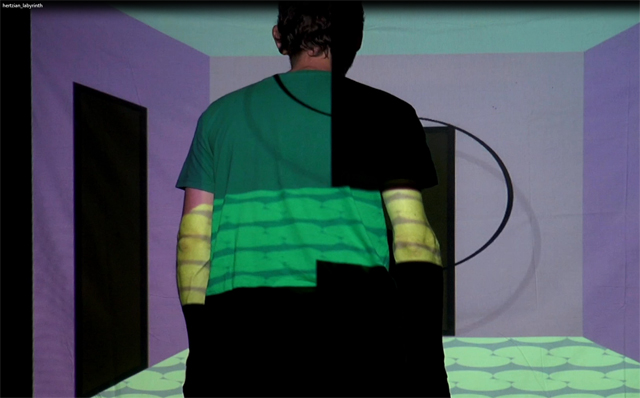
Title: Hertzian Labrynth
Artist: Jean-Michel Rolland
Medium: Installation (shown as video)
« Hertzian Labyrinth » is first of all a game designed with Processing. It can be considered as an artistic serious game able to improve the player’s listening skills. The player has to escape a series of rooms in which he’s locked. The player begins the game in the 150 Hertz frequency room, has to find the key in the 486 Hertz frequency room and go back to the 150 Hertz frequency room to escape. To open the doors, the player has to match his own frequency with the one present in the room where he stands, thus training him to recognize different frequencies and improving his listening skills. A visual help is provided by a black and white circle in the middle of the rooms. The design of the rooms (shape of the carpets, colors of the walls, ceilings and carpets) depend on the frequency of the room.
In a second time, « Hertzian Labyrinth » becomes an interactive installation which can simultaneously host from 1 to an unlimited number of visitors. The mouse is replaced by three proximity sensors installed at the bottom of the projection screen, in front of each of the three doors. These sensors calculate the distance between the visitors and the screen, modulate the frequencies generated by the visitors and allow the doors to open. Visitors interact with the installation with their bodies. When a room of the labyrinth has no door in the middle, the proximeter installed in the middle isn’t active, and so on. Only one proximeter is active at the same time. The first visitor to move in front of a proximeter retains control on the installation (the sensor in front of him is active) until :
- the room of the labyrinth where he stands has no door in front of him
- he stands still for more than one second
- he gets out of the sensor’s range and no visitor stands behind him.
In each case, one of the two other proximeters becomes active. When a visitor is far away from the proximeter, the frequency generated is low (100 hertz). The closer he goes towards the proximeter (and towards the screen), the higher the frequency becomes (maximum 500 Hertz). The three proximeters are linked to the PC with a MIDI interface directly managed by Processing. The room’s depth where “Hertzian Labyrinth” is installed must be at least three meters.
This installation allows a strong collaboration between visitors: It tends to generate collective decisions (visitors have to negotiate the direction to be taken and have to play the game of standing still when they’re in front of a door they don’t want to open). A visitor who has to lower his frequency, if he has someone behind him, has two possibilities: either going backwards with the risk of shoving, or getting out of the sensor’s range in order to let the visitor behind him become the new interactor.
